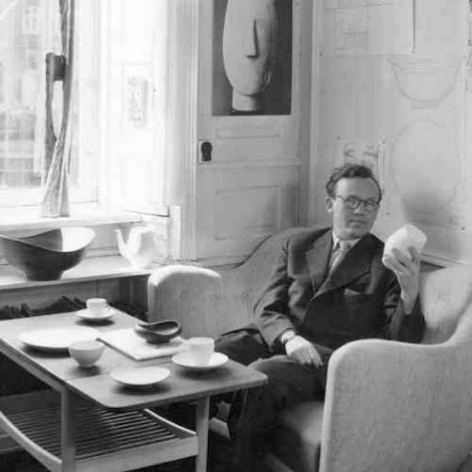

Originally Finn Juhl designed this sofa for Baker Furniture Inc. in USA in 1951. The sculptural forms are inspired by the modern free art, which interested Finn Juhl very much. The sofa has an upholstered body divided in two, resting upon an elegant and light construction of wood – a typical example of how Finn Juhl separated the elements in order to create a visual lightness. The sofa is upholstered in wool fabric, of customer’s choice.
Dimensions L195 x D80 x H98 cm – seat height 44cm
Upholstery fabric or leather
Legs oak or walnut

Baker Sofa
from









Examples:
Watercolours Rose Quartz + Watercolours Soft Linen (fabric price group 3) / Oak
Watercolours Rose Quartz + Watercolours Soft Linen (fabric price group 3) / Walnut
Watercolours Fresh sage + Watercolours Dark conifer (fabric price group 3) / Oak
Watercolours Fresh sage + Watercolours Dark conifer (fabric price group 3) / Walnut
Watercolours Soft Linen + Watercolours Pumpkin Spice (fabric price group 3) / Oak
Watercolours Soft Linen + Watercolours Pumpkin Spice (fabric price group 3) / Oak
Watercolours Golden Syrup + Watercolours Soft Linen (fabric price group 3) / Oak
Watercolours Golden Syrup + Watercolours Soft Linen (fabric price group 3) / Walnut
Watercolours Soft Linen + Watercolours Himalaya (fabric price group 3) / Oak
Watercolours Soft Linen + Watercolours Himalaya (fabric price group 3) / Walnut
Remix 123 + Remix 163 (fabric price group 1) / Oak
Remix 123 + Remix 163 (fabric price group 1) / Walnut
Remix 412 + Remix 242 (fabric price group 1) / Oak
Remix 412 + Remix 242 (fabric price group 1) / Walnut
Remix 242 + Remix 612 (fabric price group 1) / Oak
Remix 242 + Remix 612 (fabric price group 1) / Walnut
Remix 762 + Remix 123 (fabric price group 1) / Oak
Remix 762 + Remix 123 (fabric price group 1) / Walnut
Remix 823 + Remix 183 (fabric price group 1) / Oak
Remix 823 + Remix 183 (fabric price group 1) / Walnut
Hallingdal 110 + Hallingdal 376 (fabric price group 2) / Oak
Hallingdal 110 + Hallingdal 376 (fabric price group 2) / Walnut
Hallingdal 457 + Hallingdal 100 (fabric price group 2) / Oak
Hallingdal 457 + Hallingdal 100 (fabric price group 2) / Walnut
Hallingdal 227 + Hallingdal 376 (fabric price group 2) / Oak
Hallingdal 227 + Hallingdal 376 (fabric price group 2) / Walnut
Hallingdal 980 + Hallingdal 960 (fabric price group 2) / Oak
Hallingdal 980 + Hallingdal 960 (fabric price group 2) / Walnut
Hallingdal 110 + Hallingdal 764 (fabric price group 2) / Oak
Vidar 472 + Vidar 222 (fabric price group 4) / Oak
Vidar 472 + Vidar 222 (fabric price group 4) / Walnut
Vidar 443 + Vidar 1511 (fabric price group 4) / Oak
Vidar 443 + Vidar 1511 (fabric price group 4) / Walnut
Vidar 723 + Vidar 1511 (fabric price group 4) / Oak
Vidar 723 + Vidar 1511 (fabric price group 4) / Walnut
Vidar 633 + Vidar 582 (fabric price group 4) / Oak
Vidar 633 + Vidar 582 (fabric price group 4) / Walnut
Vidar 1062 + Vidar 152 (fabric price group 4) / Oak
Vidar 1062 + Vidar 152 (fabric price group 4) / Walnut
Fiord 451 + Fiord 271 (fabric price group 2) / Oak
Tonica 612 + Tonica 643 (fabric price group 2) / Walnut


Finn Juhl

As a teenager, Finn Juhl (1912-1989) wanted to become an art historian, having a passion for the fine arts since childhood. His father stopped him and Finn Juhl started architectural studies. Later, when his fame as a designer of furniture acquired, he speaks of himself as an autodidact, in reference to this upset vocation that forced him to walk intellectually on a lonely way. His style owes much to this singular trajectory, with its non academic interpretation of art visible in his work. Finn Juhl started his studies in 1930, a key period which saw the birth of modern design and furniture.
His modern offices in central Copenhagen was greeting his visitors with a huge Japanese fish in paper, symbol of imagination. Rather than thinking in terms of practical construction, Finn Juhl had the mind-set of a sculptor, when he shaped a piece of furniture. In the 1940s and 1950s, this way of working had never been seen before. His ambition was to design furniture with movement and life.
Juhl took pride in making both the structurally supportive elements of the furniture and the seated person look as though they are floating. In some of his chairs, the backrest and the seat are almost invisibly joined, as if they were clouds floating through the room.
In creating his furniture, Finn Juhl worked with two elements: The carrying element, and the carried. He eventually became known for his special ability to separate the bearing parts from the borne. This is one of many examples of how he broke free from conventional working methods and found his inspiration in art.